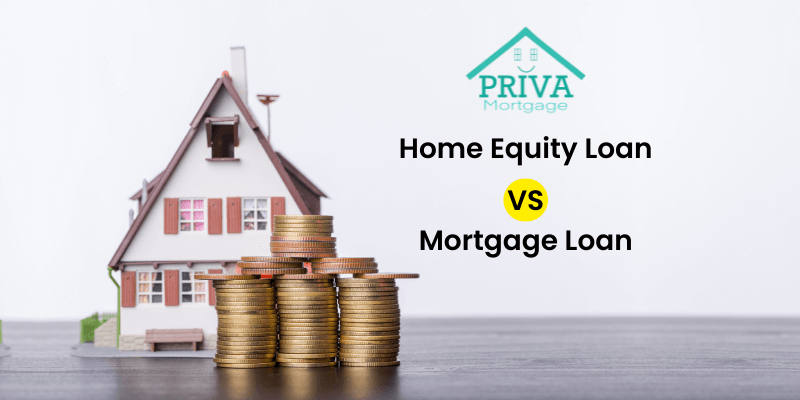You can borrow many types of loans against real estate, including a home equity loan and mortgage. Both are loans against your property, but the similarities end there.
Understanding how a home equity loan and mortgage work and what differences they have can help you determine your options for mortgage financing.
What is a Mortgage?
When you hear the term mortgage, you likely think of a conventional mortgage used to buy a house. While there are other options and uses for a mortgage, the premise is the same. You borrow money to buy a house or refinance your house. Usually, you have to make a down payment or have equity in the home of about 20%.
Other mortgage financing options include FHA, VA, and USDA loans. Each loan program has different guidelines, including down payment requirements. For example, VA loans don’t require a down payment, and FHA loans allow a down payment of just 3.5%.
Most mortgage loans are the first lien on a property. If a borrower defaults, the mortgage lender can foreclose on the home and make their money back.
What is a Home Equity Loan?
A home equity loan is another mortgage, but you typically don’t use it to buy a home. Instead, borrowers use a home equity loan to tap into their home’s equity.
Equity is the difference between your home’s current value and the amount of outstanding liens. For example, if your home is worth $400,000 and you have a first mortgage worth $100,000, you have $300,000 in equity.
Most home equity loans allow borrowers to tap into up to 80% of their home’s equity minus any existing loans.
Like a mortgage, a home equity loan uses the home as collateral.
The Differences Between a Mortgage and Home Equity Loan
A mortgage is usually used to buy a house, and a home equity loan is used to tap into a home’s equity for other purposes, like debt consolidation or home improvement, but they can serve other purposes too.
For example, you can use a cash-out refinance or a first mortgage to tap into a home’s equity, and you can use a home equity loan as a part of your down payment when buying a house.
So what are the major differences?
Loan Amounts
The loan amounts for a mortgage are typically higher than a home equity loan because the mortgage is how you buy the home.
A home equity loan usually allows up to 80% of the home’s value, but it’s a combined LTV, which means your total loans (first and second mortgage) can’t exceed 80% of the home’s value. Since the first mortgage usually is for a higher amount, home equity loans are for lower amounts.
Interest Rates
Mortgage loans typically have lower interest rates than home equity loans because they are a lower risk. Mortgage loans are in the first lien position. So if you default on your loan, the first mortgage lender gets paid first. A second mortgage lender, however, is in a second lien position and might not receive payment.
The actual difference usually isn’t much, though, and it varies by borrower. For example, a borrower with great credit and a low debt-to-income ratio may get just as attractive of an interest rate on a home equity loan as a first mortgage.
Loan Terms
Mortgage loans typically have a longer term than home equity loans. While you can find a home equity loan for 30 years, it’s rare. But most borrowers take a 30-year term for a first mortgage because the loan amount is so high, and they need more time to pay it off.
Home equity loans are usually for 10 – 20 year terms, but you might find an option for a 30-year term. The less time you borrow the money, the less interest you pay, but the higher your monthly payment is.
Loan Purpose
A mortgage is primarily used to buy a home. It’s the difference between the sales price and your down payment. So, for example, if you’re buying a home for $200,000 and you put down $20,000, you’d borrow $180,000 in a mortgage.
However, sometimes a home equity loan can be used as a part of the down payment. It’s called a piggyback loan. Here’s how it works:
· 10% down payment from your funds
· 10% from the second mortgage
· 80% from the first mortgage
However, mortgages and home equity loans can have other uses. For example, you can refinance your first mortgage with a cash-out refinance. This allows you to use your home’s equity for other purposes. Typically, borrowers can have a loan-to-value ratio of up to 80% with a cash-out refinance.
A home equity loan is typically used for purposes other than buying a house, including:
· Debt consolation
· Home renovations
· Weddings
· College
· Large expenses
· Emergency funds
How to Qualify
Mortgage loans and home equity loans both have the same approval process. You complete a loan application and prove that you can afford the property. Typically you’ll provide the following:
· Paystubs for the last 30 days
· W-2s for the last 2 years
· Tax returns for the last 2 years if you’re self-employed
· Bank statements for the last 2 months
· Proof of employment
Final Thoughts
A home equity loan and mortgage are similar, yet different. They are both liens on your property but have different purposes and qualifying factors.
If you’re buying a home, you’ll likely borrow a first mortgage, but as you build equity in the home, you may apply for a home equity loan to use the equity but keep the home. Either way, you’re borrowing against your home’s value. Make sure you can afford the payments and put the money to good use to make the most of your investment.







